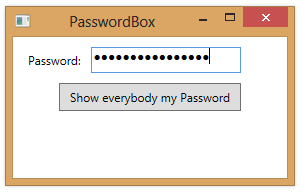

#WPF PASSWORDBOX PASSWORD#
The PasswordBox has a built-in button that the user can press to display the password text. There is no property to specify a minimum length, but you can check the password length, and perform any other validation, in your app code. Specify the maximum number of characters that the user can enter by setting the MaxLength property. This is especially useful when you have multiple boxes, such as on a form to change a password. You can use the Header and PlaceholderText properties to provide context for the PasswordBox. Here, the default bullet is replaced with a pound sign. You can change the character used to mask the password by setting the PasswordChar property.
#WPF PASSWORDBOX CODE#
Here's the result when this code runs and the user enters "Password". StatusText.Text = "'Password' is not allowed as a password." Private void passwordBox_PasswordChanged(object sender, RoutedEventArgs e) If it is, you display a message to the user. When the user enters a password, you check to see if it's the literal value, "Password". Here's the XAML for a password box control that demonstrates the default look of the PasswordBox. Or, you can use another event, like a button Click, to perform validation after the user completes the text entry. You can do this in the handler for the PasswordChanged event to perform validation while the user enters the password. Use the Password property to get or set the contents of the PasswordBox. Get the app from the Microsoft Store or get the source code on GitHub The WinUI 3 Gallery app includes interactive examples of most WinUI 3 controls, features, and functionality. Open the WinUI 3 Gallery app and see PasswordBox in action. Pressing the "reveal" button on the right gives a peek at the password text being entered: When the user types in a password box, the default behavior is to show bullets that hide the text being entered: The password box has several states, including these notable ones.Ī password box at rest can show hint text so that the user knows its purpose:


A label is visible whether or not the text input box has a value. Use a label or placeholder text if the purpose of the password box isn't clear.Use a PasswordBox control to collect a password or other private data, such as a Social Security number.įor more info about choosing the right text control, see the Text controls article. You can disable the reveal button, or provide an alternate mechanism to reveal the password, such as a check box. You can configure the placeholder character.īy default, the password box provides a way for the user to view their password by holding down a reveal button. A password box looks like a text box, except that it renders placeholder characters in place of the text that has been entered. A password box is a text input box that conceals the characters typed into it for the purpose of privacy.


 0 kommentar(er)
0 kommentar(er)
